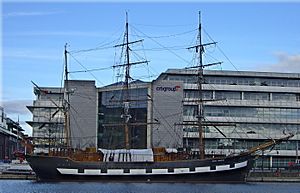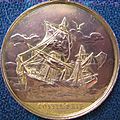Coffin ship facts for kids

Coffin ships were the name given to the ships that carried Irish families across the Atlantic to places like America and Canada. This happened during a very difficult time in Ireland called the Great Irish Famine, which lasted from 1845 to 1852. These ships were often the cheapest way to travel, but the journey was incredibly tough and dangerous.
Life on board these ships was horrible. They were very crowded, with too many people packed into small spaces. There was also very little food and water for everyone. Because of these poor conditions, diseases spread quickly among the passengers. Sadly, about one-third (30%) of the people on these ships died before they even reached their new homes in Canada or the USA.
Contents
What Were Coffin Ships?
Coffin ships were not built for passenger travel. Instead, they were usually cargo ships that had been used to carry timber or other goods. After dropping off their cargo, ship owners realized they could make extra money by filling the empty ships with people wanting to leave Ireland. They packed as many people as possible onto these ships, often far more than was safe or healthy.
Why Did People Leave Ireland?
During the Great Irish Famine, the main food source for many Irish families, the potato crop, failed year after year. This led to widespread hunger and poverty. People were desperate to find food and a better life, so they decided to leave their homes. Crossing the Atlantic was a huge risk, but for many, it felt like the only hope.
The Dangerous Journey Across the Atlantic
The trip across the Atlantic Ocean could take many weeks. Passengers lived in cramped, dark, and dirty conditions below deck. With so many people close together and poor hygiene, illnesses like typhus (also known as "famine fever") and cholera spread rapidly. Many people, especially children and the elderly, were already weak from hunger before they even boarded the ships, making them more vulnerable to disease.
Arrival in New Lands
When the coffin ships finally arrived in ports like Grosse Isle in Canada or New York in the USA, the sight was often shocking. Many ships had lost a large number of their passengers to disease and starvation. Quarantine stations were set up to try and stop the spread of illnesses, but the impact of these journeys was devastating.
Images for kids
-
The obverse side of a medal given to Samuel Plimsoll showing a coffin ship



